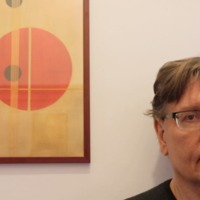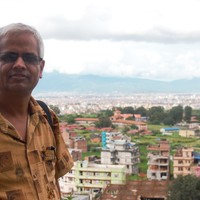Papers by Syed Irfan Ashraf

Journal of Borderlands Studies
For the last five decades, a neoliberal war has been raging through Pakistan’s Pashtun Tribal Are... more For the last five decades, a neoliberal war has been raging through Pakistan’s Pashtun Tribal Areas bordering Afghanistan. The State of Pakistan has been an active shareholder in this never-ending “war on terror.” The State’s biopolitical and racializing policies continuously reproduce the logics through which the Tribal bodies are conveniently and invisibly subjected to a regime of death and maiming. In an attempt to unsettle the State’s biopolitical mandate, we combine Michel Foucault’s biopolitics and Achille Mbembe’s necropolitics to map out the historical genealogy of the imperialist violence in the Tribal border zone. Next, we delineate and examine three major State-deployed discursive strategies through which the exceptional position of this Tribal borderspace and the expendable status of its inhabitants are constructed and naturalized. Towards the end, we also discuss PTM, a grassroots civil rights anti-war movement that is mounting a notable resistance to the necropolitical regime through a non-violent praxis rooted in Pashtun cultural traditions of resistance. The PTM, we conclude, offers an organic counter-Pashtun narrative to the world. The aim of the paper is to stimulate indigenous emancipatory perspectives in the academic literature on the Pashtun Tribal Areas and its people.

Journal of Journalism, Media Science & Creative Arts, 2023
This paper examines local journalists' practices and routines in a state of war in the Swat distr... more This paper examines local journalists' practices and routines in a state of war in the Swat district of Pakistan. In the backdrop of the U.S.-led "war on terror," Pakistan launched lingering 'counter-terror operations' targeting a militant network called the Taliban. Based on in-depth interviews with journalists in Swat and its surrounding troubled districts, this research investigates the challenges local journalists went through while reporting death and destruction. It investigates how local journalists dealt with the trauma of visceral violence in their local, national, and international media coverage. Using Pierre Bourdieu's Field Theory, especially its concepts of 'capital', 'habitus', and 'doxa', this research situates journalists and their routines at the center of troubled social life without distinguishing between the professional world and the newsroom from the community and its challenges. The paper argues that these journalists possess enough cultural and social capital; however, reporting was a challenging task as these journalists compromised journalistic principles of neutrality, objectivity, and professionalism.

Journalism Practices, 2023
Based on in-depth interviews with ethnic Pashtun war journalists, this study explores the cross-b... more Based on in-depth interviews with ethnic Pashtun war journalists, this study explores the cross-border news practices and its underlying economy in Pakistan's troubled tribal region that straddles the Pak-Afghan border. We argue that the structural remnants, including media, of the British colonialism of the past continue to boost the neo-imperialism of the present. Several studies have examined the war reporting in the Pak-Afghan border space, however, the intersection of the postcolonial State, militarization, and cross-border news labor practices is understudied. Backdropped in the critical examination of the news pursuits during the two wars: the Afghan "jihad" and the US-led "war on terror," we show how war a s business and news labor as commodity feed into each other and contribute to the making of a material and representational crisis which sustains what Jasbir Puar calls the "economy of injury." KEYWORDS Pashtun necropolitics news practices deathscapes imperialist wars Taliban [Q1] Pakistan's mostly barren and desolate but intermittently strewn with lavish valleys-Pashtun tribal region that falls alongside Afghanistan has acquired a phenomenal strategic value over the past few centuries. Caught in the geopolitical power-plays of global empires and regional contestants, this cross-border region's rocky geography, and its peoples' tribal ways of life and their symbolic architecture of meaning-making have been in constant wrestling with colonial and imperial forces. News production and its labor practices are no exception. Starting from 1980s, these "ungoverned" spaces have become a site of unique and hazardous cross-border news-gathering practices. With the bordering city of Peshawar as its initial news center, this cross-border journalism has felt its global presence, and played a significant role in making the region in the current formation-a war zone. In post-9/11 context, the US-led "war on terror" against Al-Qaida, coinciding with the privatization of airwaves in Pakistan, turned the cross-border violence into a staple diet of 24/7 commercial news cycle. In pursuit of coveted news, almost every elite global media outlet, such as the US-based CNN, NYT, and CNBC; Japan-based NHK; and Qatari-owned Al-Jazeera, also sent their single or even multiple teams to Pakistan. Similarly, global wire services like Agency France Presse (AFP), Reuters, and Associated Press (AP)-already operating in the federal capital (Islamabad) ever since the Afghan war era (1980s)also opened their makeshift offices in Peshawar. It started from the hiring of the local Pashtun journalists in lowly positions

August, 2023
For the last five decades, a neoliberal war has been raging through Pakistan’s Pashtun Tribal Are... more For the last five decades, a neoliberal war has been raging through Pakistan’s Pashtun Tribal Areas bordering Afghanistan. The State of Pakistan has been an active shareholder in this never-ending “war on terror.” The State’s biopolitical and racializing policies continuously reproduce the logics through which the Tribal bodies are conveniently and invisibly subjected to a regime of death and maiming. In an attempt to unsettle the State’s biopolitical mandate, we combine Michel Foucault’s biopolitics and Achille Mbembe’s necropolitics to map out the historical genealogy of the imperialist violence in the Tribal borderzone. Next, we delineate and examine three major State-deployed discursive strategies through which the exceptional position of this Tribal borderspace and the expendable status of its inhabitants are constructed and naturalized. Towards the end, we also discuss PTM, a grassroots civil rights anti-war movement which is mounting a notable resistance to the necropolitical regime through a non-violent praxis rooted in Pashtun cultural traditions of resistance. The PTM, we conclude, offers an organic counter Pashtun narrative to the world. The aim of the paper is to stimulate indigenous emancipatory perspectives in the academic literature on the Pashtun Tribal Areas and its people.

Liberal Arts and Social Sciences International Journal (LASSIJ)
This paper is a qualitative thematic analysis of Hermann Hesse’s novel Narcissus and Goldmund wit... more This paper is a qualitative thematic analysis of Hermann Hesse’s novel Narcissus and Goldmund with a cross-cultural theory framework, buttressed with concepts from Jungian psychology. The novel narrates the story of two medieval priests who are the exact opposite of but emotionally attached to each other. The paper demonstrates how various cultural themes that Hesse has engaged can shed light on the ways Western and Eastern societies make sense of the Self, the Other, and the everyday existential dilemmas. Based on Jungian psychology, we argue that Narcissus and Goldmund are not two distinct characters; instead, they are two aspects of the Self. The social construction of these two characters is the symbolic representation of the struggle to attain the deeper meanings of the Self. This struggle, what Jung called individuation, is the journey of the human soul into its own deepest spheres. Moreover, we note that the matrix of Hesse’s thought is the European interest in the Orient. Na...
Review of Human Rights, 2021
Swat and Dir valleys in Pakistan have seen the brunt of post 9/11 violent extremism in the recent... more Swat and Dir valleys in Pakistan have seen the brunt of post 9/11 violent extremism in the recent past. Because this extremism was generated and exploited by a few religiously motivated violent organizations, a popular perception emerged that all religious leaders of the society were involved in terrorism. Therefore, this research focuses on the role played by those religious leaders who involved themselves in mobilizing local communities against violent extremism. Employing a mixed-method research approach and sequential analysis strategy our data shows that most of the common local religious leaders played positive role in building community resilience to countering violent extremism during the early phase of the War on Terrorism in these two valleys.

Liberal Arts and Social Sciences International Journal (LASSIJ), 2021
This paper looks at the question of partition of British India in 1947 and the rise of religious ... more This paper looks at the question of partition of British India in 1947 and the rise of religious extremism in Pakistan through an analysis of internationally acclaimed and award-winning Pakistani film Khamosh Pani (silent waters). The paper uses Symbolic Interactionism and Feminist Theory with a critical perspective to establish how the present-day religious extremism in Pakistan has its roots in the colonial history of the country. However, it also highlights the diagnostic inability of Symbolic Interactionism as it smacks of the volunteerism and overlooks how statist and organized institutional power infringes upon socio-political meaning making processes. This paper argues that the film connects the communal nature of pre-partition violence to grassroots contemporary religious extremism in Pakistan to show how the rupture of a village life is the continuation of colonial heritage of communal violence. We argue based on the findings of this study that religious extremism that is m...

Central Asia
In a previous paper (in Press), we adopted a critical theory approach to argue that the model of ... more In a previous paper (in Press), we adopted a critical theory approach to argue that the model of objective journalism, while laying emphasis on neutrality and detachment, disconnects local reporters, in conflict scenario, from feeling the pain of their own ethnic community. Therefore, the objectivity model was found too simple to help ethnic Pashtun journalists know occupational intricacies of conflict-sensitive reporting in Pakistan’s northwestern terror-hit areas, a site for the U.S-led so-called global war on terror. Using phenomenology as a method, I take this argument further and offer my shared journalistic experience as a resource to establish that objectivity obfuscates power politics involved in text production while promoting an ahistorical culture. This is done through objectifying the local reporter’s relationship with the troubled site of occurrence (field), a relationship in which a reporter is made insensitive to his own presence as an ethnic body standing at a highly...

International Communication Gazette, 2015
In June of 2012, global media attention turned to the deadly violence erupting in Western Burma/M... more In June of 2012, global media attention turned to the deadly violence erupting in Western Burma/Myanmar between the Rakhine Buddhists and the stateless Muslim Rohingya, widely identified as one of the world's most persecuted minorities. This study employs critical human rights theory and literature on the use of emotion in media to analyze the constructions of the Rohingya situation in The New York Times (NYT), Inter Press Service (IPS). and the largest and most active Rohingya Facebook site, the Rohingya Community page. The Facebook page engages in an obvious politics of immediation, in which social actors mobilize extreme, violent victim images to provoke global political activism. Surprisingly, the NYT employs a similarly straightforward delineation of the savage–victim–savior framework while the IPS coverage is far more complex. This suggests the utility of a concept we have called the corporate politics of immediation and raises important questions about mainstream conflict...

Journal of Media Sciences, 2022
Having established its economic power globally, China is now also asserting its soft power in the... more Having established its economic power globally, China is now also asserting its soft power in the international symbolic representational realm-largely dominated by the West. This paper critically evaluates how BBC discursively constructs China in its Online English and Urdu News, and discusses its attendant social, political, and economic implications for the Chinese and Pakistani citizens in particular, and for people all over the world. We also discuss how does the West perceive China's efforts to establish a global soft image and what role BBC plays in it. Using a combination of research tools; Framing, Authorship and Sourcing, the study analyzed 115 news stories. The analysis revealed that 'China-Threat' is the dominant frame in BBC's coverage of China. Second, all stories were written by correspondents stationed outside China. Finally, BBC disproportionately cited Western news/expert sources, and also many sources/reports were unspecified (anonymous). The aim of this paper is to prompt readers to question commonly held assumptions of China propagated mostly by Western media.

Journal of digital media & policy, 2022
Due to the State's militarized policies in the war-torn Pashtun areas (ex-FATA) bordering Afghani... more Due to the State's militarized policies in the war-torn Pashtun areas (ex-FATA) bordering Afghanistan, the Pakistan government's undeclared internet policy in this region has become an obstacle in the way of both exercising the freedom of expression and the attainment of digital access as a basic human right. This is in line with the colonial legacy of keeping this area a buffer-zone, strategically rendering it an information black hole. But the criminalization of digital freedom has also triggered local protests for media-making rights. Based on interviews with 'tribal' students, and using critical discourse analysis in combination with Achille Mbembe's concept of necropolitics, we examine how the Pakistani State denies the tribal students their digital rights resulting in the loss of their time and the consequences of this collective loss. We found that the local frustration could not be limited to the lack of internet. Entailing an element of passive defiance, the tribal students are deserting their ancestral land to reclaim their bodies from the goliath

Liberal Arts & Social Sciences International Journal (LASSIJ), 2022
The material consequences of the US-led "war on terror" in Pakistan are always counted in statist... more The material consequences of the US-led "war on terror" in Pakistan are always counted in statistical terms, that is, the number of casualties in drone strikes or suicide bombings. Little attention, however, is paid to the local public imagination to know how the ordinary people consume this everyday destruction and what kind of cultural production it ensures that shapes and inspires their imagination. In this study, therefore, we discuss the way systemic violence and cultural expression reinforce each other and how such an uneasy configuration depicts the pain and injury of people affected by this global war. We examine a purposive sample of Pashto tapey-anonymous couplets attributed to Pashtun women and conventionally reflecting war, valour, grief, longing, and love-to gain an insight into how this folk literature engages militarized violence, embraces the political and ideological challenges of the war, and reveals the hidden power contestation between actual militarization and symbolic representation. A close reading of these tapey depicts that Pashtun life is not only subjected to a rule of death, what Mbembe calls, "necropolitics" but these tapey create their own necrospace in local enunciative and cultural practices, thus reinforcing militarised violence in a cultural sphere.

Journal of Political Studies, 2016
IntroductionGenerally, scholars writing on the political economy of media make top-down analysis ... more IntroductionGenerally, scholars writing on the political economy of media make top-down analysis of the media scene.1This assumption could not be overlooked in the study of many classic accounts concerning media ownership, corporate interests, mergers and lack of heterogeneity in media content especially in Pakistan. Herman and Chomsky's (1988) propaganda model is no exception to this culture, which we use as a theoretical framework of this study. Despite providing an effective framework for addressing key areas of the political economy, the model invites critique from many scholars (Hallin 1994;Holsti & Rosenau, 174; Klaehn 2002, p. 147-182; Romano, 1989).2 These scholars argue that Herman and Chomsky (1988) promote a mechanical and functionalist approach. Herman and Chomsky (1982) acknowledge leaving out many factors at secondary level by not making them the subject of their analysis. According to Chomsky's biographer Rai (1997) said: "The kind of micro-analyses is no...
British Journalism Review, 2014
British Journalism Review, 2013

Counterinsurgency description is attaining impetus, as Pakhtun territory in Afghanistan and Pakis... more Counterinsurgency description is attaining impetus, as Pakhtun territory in Afghanistan and Pakistan remains engulfed in conflict. The War on Terror announced in the US just after 9/11 is fought in the region with full force and might. However, the use of excessive military force has yet not mustered positive results. Operation Geronimo (killing of Osama Bin Ladin) could not gain any sympathies for the allies; rather Pakhtuns are angry over the violation of their territorial integrity. Focusing upon them (Al Qaeda and the Taliban), it will become clear how the two perceive terrorism and Jihad with their varying attitudes towards one another vis-a-vis Pakhtun society. Terrorism does not have static characteristics; tactics employed and targets adopted have evolved over time. The Taliban and Al Qaeda’s interpretation of jihad, and the conviction and tactics of their undertakings command similar influence over the Pakhtun society in particular and the international community in general.

The fixer on the Pak-Afghan frontier: A de-skilled local labour in the global media, 2021
This study examines power misuse in global news production by focusing on the role of "fixer." Fi... more This study examines power misuse in global news production by focusing on the role of "fixer." Fixer is a local journalist who reports for global media on conflict-riddled areas or crisis situations. By interviewing forty fixers in Pakistan's war-hit Pashtun Belt along the Afghanistan border, I examine the challenges they face in working with the global media's visiting journalists before the start of the war on terror. Using Marx's concept of proletarianization which is a process in which capital transforms a great mass of society into daily wage workers, I reveal how the local journalist, who works as fixer, is not only de-professionalized, but his precarity, due to living in a war zone, also forces him to misuse his local news traditions in working for the global media. I argue that fixers are far more than just assistants to global media outlets. Not only are they all practicing journalists in their own right, but, as locals, they also are geographically better placed to use their experience than those journalists who are coming from outside the conflict zone. Yet, this subsidiary role automatically erases this distinction leading to the real fixers' de-skilling with consequences for the entire region.
Review on Human Rights, 2021
comAbstractSwat and Dir valleys in Pakistan have seen the brunt of post 9/11 violent e... more comAbstractSwat and Dir valleys in Pakistan have seen the brunt of post 9/11 violent extremism in the recent past. Because this extremism was generated and exploited by a few religiously motivated violent organizations, a popular perception emerged that all religious leadersof the society were involved in terrorism. Therefore, this research focuses onthe role played by thosereligious leaders who involved themselves in mobilizing local communities againstviolent extremism. Employing a mixed-method research approach and sequential analysis strategy our data shows that most of the common local religious leaders played positive role in building community resilience to countering violent extremism during the early phase of the War on Terrorism in these two valleys. Key words:Community Resilience, Dir, Religious Leaders,Swat,Terrorism,Violent Extremism.
REVIEW
International Journal Of Pukhtunkhwa, 2020
I started journalism in 1997. For over a decade and a half, I was a local journalist working with... more I started journalism in 1997. For over a decade and a half, I was a local journalist working with a National TV channel, Dawn News. I also worked with different foreign news networks as a fixer including the NYT. Along with doing practical journalism, I also started teaching at the department of Mass Communication, University of Peshawar in 2004 and went for Ph.D. to the U.S in 2012. I also remained an article writer for Pakistan leading English daily, Dawn. My journalistic work was mainly related to writing commentary and making TV packages on militancy and media in Pakistan's Pashtun tribal belt (FATA). In 2014, Syracuse University awarded me the Mirror Award for best commentary on legacy media. I was a co-producer of the award winning documentary on Malala titled "class dismissed".











Uploads
Papers by Syed Irfan Ashraf
REVIEW
REVIEW